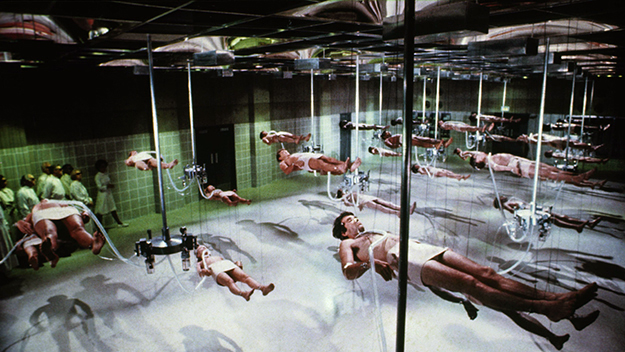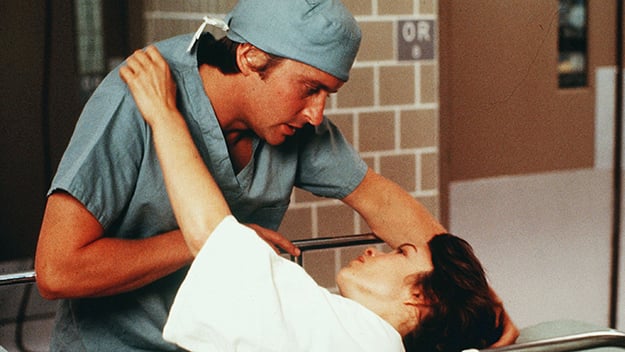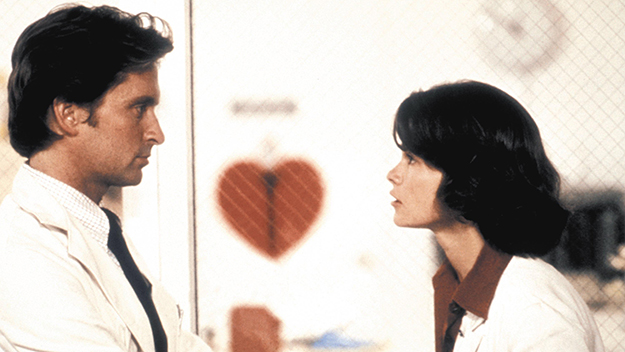TCM Diary: Coma

Images from Coma (Michael Crichton, 1978)
Writer-director Michael Crichton’s critically forgotten 1978 smash, Coma, is a brisk, scary, clever thriller based on Robin Cook’s bestseller about a body-snatching scam in a Boston teaching hospital. When it came out, this macabre tale about a dedicated young doctor uncovering surgical skullduggery in the organ trade was topically linked to controversies surrounding both the Karen Ann Quinlan case and the unregulated practice of procuring organs for transplant. (Quinlan, who had died after mixing Valium with alcohol, was kept on a ventilator for over a year, in a vegetative state, against her family’s wishes; the United Network for Organ Sharing wasn’t established until 1984.)
Today, Coma’s step-by-step depiction of anesthesia intubation—the procedure both introduces the plot and provides the climax—will rattle audiences already unnerved by news of ventilator shortfalls. Though Coma lacks the éclat of a classic horror-suspense film, it has considerable virtues all its own. In Genevieve Bujold, it has an incandescent and intrepid heroine. You could say she has heart… and liver… and kidneys…. And Crichton conjures some spooky, metaphoric images: scenes set in a futuristic clearing house for the comatose and among the corpses of an anatomy lab could be called Days and Nights of the Living Dead.
Producer Martin Erlichman, prime mover for the movie, knew Crichton was the man to make it. The then-36-year-old Harvard MD and summa cum laude in biological anthropology had been a blockbuster author since The Andromeda Strain (1969). He had also penned his acclaimed nonfiction book Five Patients (1970), drawing on his own experiences at Massachusetts General Hospital, and the medical thriller A Case of Need (1968), under the pseudonym Jeffrey Hudson (source of the 1972 Blake Edwards film The Carey Treatment). Moreover, in 1973, Crichton displayed a flair for provocative suspense in his big-screen directorial debut, the low-budget sci-fi sensation Westworld—now an expensive HBO series with a wide and avid following. Crichton had his own special enthusiasm for Coma. As he told me during an interview at the time, “When we started work in 1976, the recent women’s movies [Julia, The Turning Point, Annie Hall, Looking for Mr. Goodbar] had not yet appeared. Coma had that rarity—a strong heroine with an important job and hence a personality structure similar to a traditional male’s. Coma is still unique because its heroine has the Paul Newman role—her womanhood becomes an issue only as part of the story.”
Simply by freshly observing a familiar milieu, Crichton emerged with a light, deft exposé of institutional sexism. When Bujold confronts the hospital’s male hierarchy, including Rip Torn as chief of anesthesiology and Richard Widmark as chief of surgery, we sense the condescension and mistrust bristling beneath the surface, even before Widmark mutters, “Women! Christ!” One witty shot of Torn and his all-female lab staff smirking at Bujold suggests a potential spinoff: The Stepford Hospital.

Bujold grows to suspect that a conspiracy is making young, healthy patients like Lois Chiles and Tom Selleck brain-dead and shipping them off to the forbidding Jefferson Institute, where their bodies are harvested for transplant organs that go to the highest international bidders. She uncovers the villainy of a doctor with a God complex, but the only actual conspiracy concerns the Y chromosome. Bujold’s ambitious, conventional boyfriend, played by Michael Douglas, is a surgical resident like herself. But he’s on course to be the chief surgical resident. The current chief resident tells him that the hospital wouldn’t can the snoopy Bujold because of the bad publicity that would come from firing a female. But Douglas will never replace him unless he can restrain his girlfriend.
Sigourney Weaver usually gets the credit as the breakthrough female action star for Alien (1979). Bujold, though, beat Weaver to the punch a year earlier, playing life-or-death games of Chutes and Ladders as she scrambles through hidden passages or outwits a ghoulish hit man. According to Crichton, “The only other actress who could have pulled it off is Jane Fonda.” Bujold is an emotional and intellectual fireball. She also delivers an intensely physical performance, whether she’s scrambling up vertiginous steps, hiding atop a dropped ceiling, or frolicking with Douglas on a North Shore beach. Who cares that we’re watching a dated Seventies romantic montage when Bujold so acutely conveys sensual release? It makes glorious sense that when Bujold tells Douglas she doesn’t want to miss “a class,” it turns out to be a dance class. At one point, when the plot thickens, she must straddle the space between a towering ladder and a horizontal shaft. She loses a shoe, deliberately drops the other one, then wriggles out of her pantyhose. It’s a feminist high-wire act—the pantyhose pays off in the craftily plotted script.
Coma should have marked Bujold’s emergence as a superstar. Instead it stands out as one of the few times a commercial filmmaker knew what to do with her. Crichton stressed to me the actor’s stamina and professionalism: “The shadows under the eyes come from working three months with only two or three days rest. And that look fits the role.” Except for that North Shore weekend, she goes through the entire film wearing the same white jacket and skirt and checked shirt. Climbing up the insides of imposing buildings, she’s The Woman in the White Suit. “We could have made her more glamorous, but she wanted to do it straight, which is outrageous in the closed world of Hollywood.”
Early on, Crichton’s journalistic authority roots the story in a recognizable time and place. When Bujold tools into work in her cute convertible, the radio spouts news of bribery and corruption in Beantown. The doctors’ banter revolves around investments, office politics, and dating. They’re acting like yuppies a half-dozen years before the term was coined. When Bujold and Douglas go to his place after work, they argue about who gets to take a shower first and who should start heating the dinner she’s already prepared. Their behavior brings back an earlier, burgeoning feminist era.

Chiles and Selleck make such strong visual impressions that we register their loss even though, on paper, their characters barely exist. Better yet, a very young Ed Harris does one of his nifty sardonic turns as a pathology resident who swaps ideas with a lab-mate about the perfect way to kill a patient.
Crichton succeeds at mixing black humor with horror when Bujold tours a formidable and mysterious coma warehouse, overseen by administrator Elizabeth Ashley. Caretakers suspend impeccably preserved bodies from wires in a warm, mauve-toned hall; unseen computers govern all their biological functions. Director Crichton makes this coma heaven look like what he called “an inviting womb.” (It’s also eerily disconcerting.) Screenwriter Crichton proves his own dictum: “technology is dangerous only if it is seductive.” By the end, we’re back in the initial hospital settings, and Crichton has accomplished his goal: compelling us to view them less complacently.
In his autobiography, Avid Reader, Robert Gottlieb, Crichton’s book editor in his early glory days, credited the writer with launching “an armada of what came to be called techno-thrillers” in a genre pioneered by Mary Shelley, Arthur Conan Doyle (the original The Lost World), and H.G. Wells. “He had a keen eye, or nose, for cutting-edge areas of science—and, later, sociology—that could be used as material for thrillers while cleverly popularizing the hard stuff for the general public. You got a lesson while you were being scared…. [He could] do everything necessary except create convincing human beings. (He never did manage to; eventually I concluded that he couldn’t write about people because they just didn’t interest him.)”
In movies, though, actors can fill gaps with their own personalities. In his first few movies, from Westworld through his lavish, captivating Victorian caper, The Great Train Robbery (1978), Crichton’s novel ideas and tip-top casts help him create first-rate escapist entertainment. Yul Brynner and Richard Benjamin are the ultimate in masculine yin and yang in Westworld, and Sean Connery, Lesley-Anne Down, and Donald Sutherland are the slyest of rogues in Train Robbery. At the top of the heap is Bujold’s magnetic, breakneck performance in Coma.
Coma airs on Turner Classic Movies on April 15.
Michael Sragow is a contributing editor to Film Comment and writes its Deep Focus column. He is a member of the National Society of Film Critics and the Los Angeles Film Critics Association.







